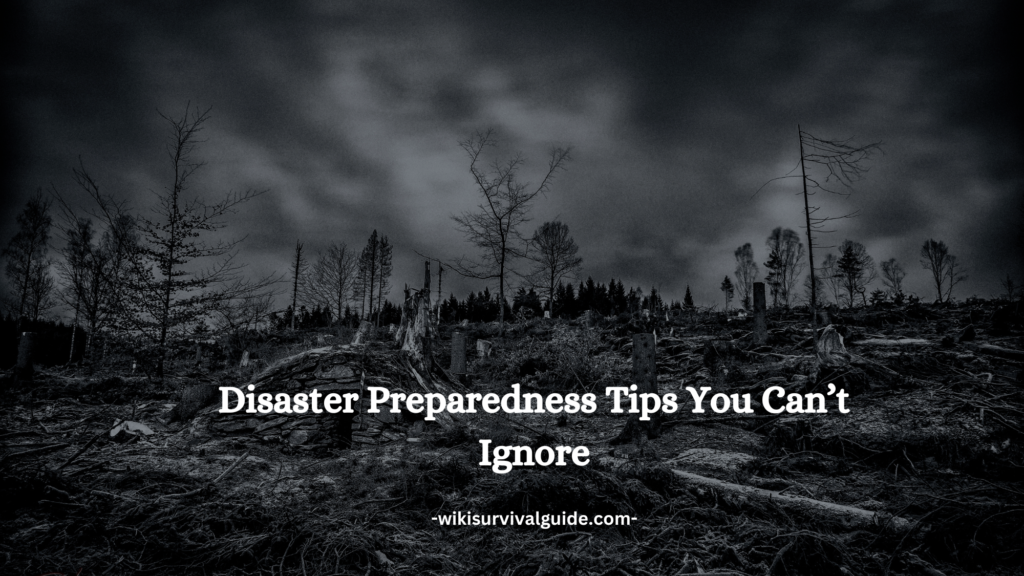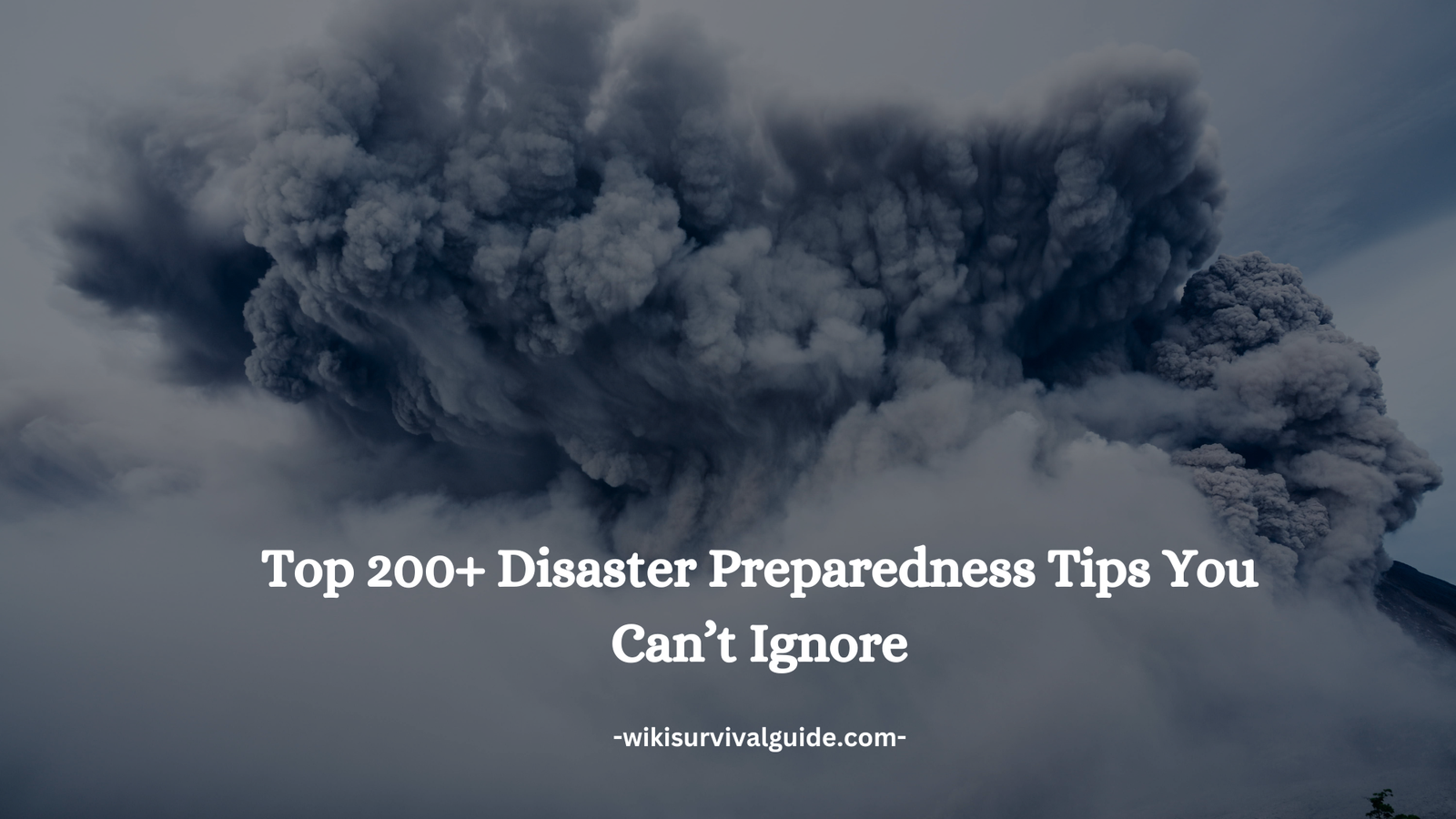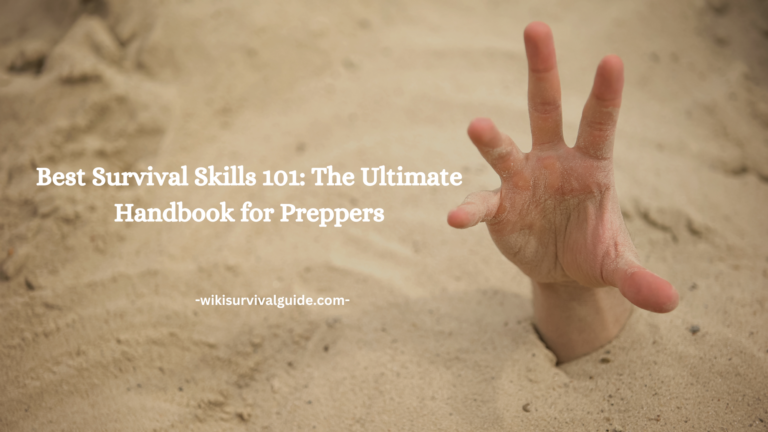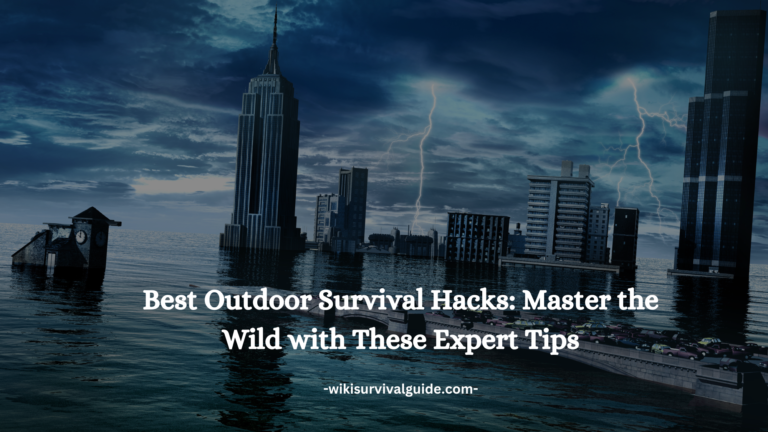Disasters strike without warning, and being unprepared can put you and your loved ones at serious risk. Whether it’s a hurricane, earthquake, wildfire, or even a power outage, having the right knowledge and supplies can make all the difference. In this ultimate guide, we’ll cover Top 200+ Disaster Preparedness Tips You Can’t Ignore to help you stay ready for anything.

General Disaster Preparedness
Disaster preparedness is essential to minimize risks and ensure safety during emergencies. A well-structured plan helps individuals, families, and communities respond effectively to various disasters, including natural calamities like earthquakes, hurricanes, floods, and wildfires, as well as human-made crises such as power outages and industrial accidents.
A comprehensive disaster preparedness plan includes understanding potential hazards in your area, assembling an emergency kit, and practicing evacuation routes. The emergency kit should contain essentials such as non-perishable food, water, first aid supplies, flashlights, batteries, and necessary medications. Additionally, keeping important documents, emergency cash, and a battery-powered radio ensures access to critical information during disruptions.
Staying informed about local alerts and warnings is another vital aspect of preparedness. Many governments and organizations provide mobile alerts, weather updates, and emergency response guidelines. It is essential to know evacuation routes and shelter locations in case of immediate threats.
Community involvement plays a crucial role in disaster preparedness. Local volunteer groups, disaster response teams, and training programs enhance public resilience. Learning basic survival skills, such as CPR and first aid, can make a significant difference during emergencies.
Regularly reviewing and updating your preparedness plan ensures effectiveness when a disaster strikes. Conducting drills, checking supplies for expiration dates, and educating family members about emergency procedures improve readiness. With proper disaster preparedness, individuals can reduce panic, minimize damage, and enhance survival outcomes.
Emergency Communication Planning
Effective communication during emergencies ensures that family members, friends, and first responders can stay connected and informed. A well-structured emergency communication plan provides a clear strategy for how to contact loved ones, receive updates, and request assistance when standard communication networks may be down.
The first step in emergency communication planning is to compile a contact list that includes family members, close friends, medical providers, and emergency services. Each household member should have a copy of this list, stored both digitally and in a physical format.
Establishing multiple methods of communication is vital. Mobile phones, landlines, two-way radios, and satellite phones provide alternatives if primary networks fail. Text messages often work better than calls during emergencies due to reduced network congestion. Social media platforms and emergency apps can also serve as useful tools for updates and information sharing.
A designated out-of-town contact can act as a central point for relaying messages if local communication channels are compromised. Family members should be instructed to check in with this contact during a disaster.
Additionally, pre-planning meeting locations helps in cases where communication is entirely disrupted. One primary meeting spot near home and a secondary location outside the immediate area ensures that family members can reunite safely.
Practicing emergency communication plans through regular drills is essential to ensure that all members understand procedures. By preparing in advance, households can maintain contact, share critical information, and coordinate effective responses during emergencies.
Family and Household Preparedness
Ensuring that every household member is prepared for an emergency reduces stress and increases safety. A family preparedness plan outlines evacuation procedures, emergency contacts, and necessary supplies to sustain individuals during disasters.
A key component of household preparedness is assembling an emergency kit tailored to the needs of each family member, including pets. This kit should contain food, water, first aid supplies, hygiene products, flashlights, batteries, and essential medications. It is advisable to store enough provisions for at least three days.
Establishing clear evacuation routes is crucial, with at least two escape paths from the home. Family members should know how to turn off utilities such as gas, water, and electricity if instructed by authorities. Practicing fire drills and other emergency scenarios helps reinforce preparedness.
For families with children, elderly individuals, or members with special needs, additional planning is necessary. Assigning responsibilities ensures that everyone understands their role in an emergency. Teaching children how to dial emergency numbers and recognize warning signs fosters early awareness.
Staying informed about local emergency plans, shelter locations, and community resources improves preparedness. It is also essential to have a communication strategy in place to stay connected if separated.
Regularly reviewing and updating preparedness plans keeps them relevant and effective. By taking proactive measures, families can navigate crises with confidence and reduce the risks associated with disasters.
Food and Water Storage
Proper food and water storage is crucial for survival during disasters when access to fresh supplies may be limited. Having an adequate stockpile ensures that individuals and families can sustain themselves during emergencies.
Water is the most critical necessity. The recommended storage amount is at least one gallon per person per day for a minimum of three days, but ideally two weeks’ worth should be stored. Water should be kept in food-grade, BPA-free containers, and stored in a cool, dark place. Water purification methods, such as filters, purification tablets, or boiling, should also be available.
Non-perishable food items should be prioritized. Canned goods, dried fruits, nuts, protein bars, and freeze-dried meals provide long-lasting nutrition. It is essential to store food that requires minimal preparation and does not depend on refrigeration.
A manual can opener, disposable utensils, and a portable stove or fuel source ensure that food can be accessed and prepared if electricity or gas is unavailable. Rotating food supplies every six months prevents spoilage, and labeling expiration dates helps maintain a fresh stock.
Special dietary needs should be considered, ensuring that infants, elderly individuals, and those with medical conditions have suitable food options. Pet food should also be included in household storage plans.
Proper storage conditions are key to food longevity. Keeping supplies in airtight containers and storing them in a dry, cool place prevents contamination and spoilage.
By maintaining a well-planned food and water storage system, households can endure disasters with minimal disruption and sustain themselves until normal resources become available again.
First Aid and Medical Preparedness
Being medically prepared for emergencies can mean the difference between life and death. A well-stocked first aid kit and basic medical knowledge enable individuals to handle injuries, illnesses, and other health concerns until professional help arrives.
A comprehensive first aid kit should include bandages, gauze, antiseptics, pain relievers, adhesive tape, scissors, tweezers, gloves, a thermometer, and prescribed medications. Additionally, emergency supplies like EpiPens, inhalers, and insulin should be included for those with specific medical conditions.
Knowing basic first aid techniques is essential. Skills such as wound care, CPR, Heimlich maneuver, and treating burns or fractures can prevent minor injuries from becoming life-threatening. Enrolling in first aid and CPR training courses ensures preparedness.
During disasters, access to medical facilities may be delayed. It is advisable to keep a printed copy of family medical histories, prescriptions, allergies, and emergency contacts. A portable first aid manual provides guidance when internet access is unavailable.
Hygiene and sanitation are critical in emergencies. Stockpiling personal hygiene items such as soap, hand sanitizer, and disinfectant wipes prevents infections. Safe disposal of medical waste, such as used bandages or needles, also helps maintain a healthy environment.
For long-term preparedness, backup plans for medical needs should be established. Extra supplies of prescription medications, alternative treatment options, and knowledge of local medical resources can be lifesaving. By integrating first aid and medical preparedness into disaster planning, individuals can respond effectively to health emergencies.
Survival Gear and Tools
The right survival gear and tools significantly enhance safety and self-sufficiency during disasters. Having essential equipment ready ensures that individuals can navigate unpredictable situations, whether sheltering in place or evacuating.
A well-prepared survival kit includes multi-purpose tools such as a Swiss Army knife, duct tape, paracord, and a compact shovel. A flashlight with extra batteries or a hand-crank model provides light when power is unavailable. Fire-starting tools, including waterproof matches, a lighter, and fire steel, ensure warmth and cooking capabilities.
Navigation and communication tools are crucial. A battery-powered or hand-crank radio keeps individuals informed of emergency broadcasts, while a whistle and signal mirror help in rescue situations. A topographic map and compass serve as reliable navigation aids if GPS fails.
For shelter and warmth, emergency blankets, tarps, and sleeping bags provide insulation against harsh weather conditions. A tent or durable plastic sheeting can serve as temporary shelter when needed.
Water filtration and purification tools are vital for hydration. A portable water filter, purification tablets, or a small boiling pot can make contaminated water safe to drink.
Carrying enough food is necessary for survival. High-calorie food bars, dehydrated meals, and lightweight protein sources like nuts and jerky sustain energy levels. A portable stove with fuel or a solar cooker facilitates food preparation.
Maintaining and periodically updating survival gear ensures functionality. By equipping themselves with the right tools, individuals can increase their resilience in disaster situations.
Home Safety and Disaster-Proofing
Securing a home against potential disasters minimizes damage and enhances safety. Disaster-proofing involves reinforcing structures, ensuring proper utility management, and having emergency plans in place.
For earthquake-prone areas, securing heavy furniture to walls, installing flexible gas lines, and reinforcing foundations reduce risks. In hurricane zones, storm shutters, reinforced doors, and flood barriers protect homes from strong winds and rising water. Fire safety measures include installing smoke detectors, keeping fire extinguishers accessible, and maintaining defensible space around the property.
Power outages are common during disasters. Backup generators, solar panels, and battery-operated devices provide alternative energy sources. Surge protectors prevent electrical damage when power returns.
Emergency exits should be easily accessible, with clear escape routes mapped out for all household members. Fire escape ladders for multi-story homes and accessible doorways ensure swift evacuation when needed.
Storing hazardous materials properly reduces risks. Gasoline, propane, and chemicals should be kept in ventilated areas away from living spaces.
Regular inspections and maintenance improve a home’s disaster resilience. Checking the roof, windows, plumbing, and electrical systems for vulnerabilities helps prevent future damage. By implementing home safety measures, individuals can reduce risks and improve their ability to withstand disasters.
Evacuation Planning and Execution
A well-planned evacuation strategy is crucial for ensuring safety when disasters require immediate relocation. Having a clear plan helps individuals act quickly and efficiently.
The first step in evacuation planning is identifying potential threats and knowing local evacuation routes. Maps with marked routes should be stored both digitally and physically. It is also essential to be aware of designated shelters and safe zones.
A go-bag with essential supplies should always be ready. This kit should include water, non-perishable food, important documents, first aid items, clothing, cash, and multi-purpose tools. Each family member should have their own bag suited to their needs.
Transportation plans are critical. Ensuring vehicles have full fuel tanks, spare tires, and emergency kits prevents last-minute scrambling. For those without personal transportation, knowing public transit evacuation options is essential.
Communication plays a vital role in evacuation execution. Establishing a family emergency contact plan ensures that all members stay connected. A central out-of-town contact can help relay messages if local networks fail.
Pets and livestock should also be considered in evacuation plans. Pet carriers, food, water, and medical records should be prepared in advance.
Practicing evacuation drills improves readiness. Regularly reviewing plans with family members ensures that everyone knows their roles and responsibilities. A well-organized evacuation plan reduces confusion, minimizes risks, and increases the likelihood of a safe outcome.
Shelter-in-Place Strategies
Sheltering in place is a critical emergency response strategy that involves staying indoors during disasters such as chemical spills, extreme weather, or civil disturbances. Proper preparation ensures safety and sustains household members until it is safe to leave.
The first step in sheltering in place is selecting a secure location within the home. Ideally, this should be an interior room with no windows and access to necessary supplies. For chemical or biological threats, sealing doors, windows, and vents with plastic sheeting and duct tape prevents contamination.
A well-stocked emergency kit is essential. It should include at least a three-day supply of food and water, first aid supplies, flashlights, batteries, a battery-powered radio, and necessary medications. Sanitation supplies such as disinfectants, garbage bags, and a portable toilet system are also vital.
Communication is crucial during shelter-in-place situations. Staying informed through emergency alerts, radio broadcasts, and online sources helps individuals assess when it is safe to leave. Establishing a family communication plan ensures that everyone knows what to do if they are separated when sheltering begins.
Maintaining air quality is important, especially in chemical-related emergencies. Turning off HVAC systems and closing all ventilation sources prevents exposure to hazardous materials.
Shelter-in-place drills should be practiced periodically to ensure that all household members understand procedures. By preparing in advance, individuals can stay safe and comfortable while waiting for official instructions.
Financial and Insurance Preparedness
Financial readiness is a crucial aspect of disaster preparedness, ensuring that individuals and families can recover quickly from emergencies. A solid financial plan includes emergency savings, proper insurance coverage, and secure access to critical financial documents.
An emergency fund with at least three to six months’ worth of living expenses helps cover unexpected costs during and after a disaster. Keeping a portion of this in cash is important, as ATMs and digital payment systems may be unavailable during crises.
Insurance plays a vital role in financial preparedness. Reviewing and updating policies, including homeowners, renters, health, life, and auto insurance, ensures adequate coverage. Flood, earthquake, or wildfire insurance may be necessary, depending on location. Understanding policy terms, deductibles, and claim procedures helps in post-disaster recovery.
Safeguarding important financial documents is essential. Copies of identification, insurance policies, bank statements, property deeds, and medical records should be stored in waterproof, fireproof containers. Digital copies should be backed up in a secure cloud or external drive.
Having an emergency budget helps manage expenses efficiently when income is disrupted. Knowing which bills to prioritize and contacting creditors for assistance can ease financial stress.
By integrating financial preparedness into overall disaster planning, individuals can reduce economic hardships and ensure a smoother recovery process.
Power Outage and Energy Backup Solutions
Power outages are common during disasters and can last from hours to weeks. Having energy backup solutions ensures that essential appliances and devices remain functional.
A primary solution is a backup power system, such as a portable generator or home solar battery. Generators should be fueled and tested regularly, and they must be operated outdoors to prevent carbon monoxide poisoning. Solar panels with battery storage provide a renewable and quieter alternative.
Battery-powered and hand-crank devices, including flashlights, radios, and phone chargers, offer reliable communication and lighting. Keeping extra batteries and power banks ensures that devices remain operational.
Reducing energy consumption during outages helps extend power availability. Unplugging non-essential appliances prevents power surges when electricity is restored. LED lanterns and rechargeable lights provide long-lasting illumination.
Food preservation is critical during extended blackouts. Keeping refrigerator and freezer doors closed maintains food temperatures for longer. Dry ice or coolers with ice packs can help extend food storage.
Alternative heating and cooling solutions should be considered, especially in extreme weather conditions. Propane heaters, insulated blankets, and layered clothing provide warmth in cold weather, while battery-powered fans and ventilation strategies help in hot conditions.
By planning ahead for power disruptions, households can maintain comfort, safety, and access to critical resources.
Fire Safety and Prevention
Fire safety is an essential component of disaster preparedness, as fires can spread rapidly and cause significant damage. Preventative measures, fire response planning, and proper equipment reduce risks and improve household safety.
Fire prevention starts with minimizing hazards. Ensuring that electrical wiring is in good condition, avoiding overloaded outlets, and properly maintaining appliances reduces fire risks. Flammable materials such as paper, chemicals, and cooking oil should be stored safely away from heat sources.
Smoke alarms and fire extinguishers are vital tools. Smoke detectors should be installed on every level of the home, tested monthly, and have batteries replaced annually. Fire extinguishers should be placed in key areas such as the kitchen, garage, and near fireplaces. Knowing how to use a fire extinguisher correctly can prevent a small fire from escalating.
A fire escape plan ensures that all household members can exit quickly and safely. Identifying two escape routes from every room, practicing fire drills, and designating a safe meeting point outside the home enhances readiness.
Cooking safety is another important factor. Never leaving cooking unattended, keeping flammable materials away from stoves, and turning off appliances after use reduce kitchen fire risks.
For wildfire-prone areas, creating defensible space around the home by clearing dry vegetation and using fire-resistant materials for construction provides additional protection.
By implementing strong fire prevention strategies and response plans, households can significantly reduce fire-related risks and improve overall safety.
Flood Preparedness and Response
Floods are among the most common and destructive natural disasters, causing widespread damage and life-threatening conditions. Proper preparedness and response measures help minimize risks and ensure safety.
Preparation starts with understanding flood risks. Checking flood maps and local floodplain information helps determine the likelihood of flooding in a given area. Homes in flood-prone zones should have flood insurance, as standard homeowners’ policies often do not cover flood damage.
A flood emergency kit should include water, non-perishable food, flashlights, batteries, waterproof clothing, important documents in waterproof containers, and first aid supplies. Sandbags or water barriers can help prevent water from entering homes. Elevating electrical systems, appliances, and valuables reduces damage risks.
During a flood warning, staying informed through weather alerts and emergency broadcasts is critical. If evacuation is advised, leaving early prevents getting trapped by rising waters. If staying home, moving to higher floors and avoiding basements minimizes exposure to floodwaters.
Driving or walking through floodwaters is dangerous, as just a few inches of moving water can sweep away vehicles and people. It is best to wait for official clearance before returning home after a flood.
Post-flood safety measures include checking for structural damage, avoiding contaminated water, and wearing protective gear when cleaning up. By preparing in advance and responding effectively, individuals can reduce the impact of flooding and protect themselves from harm.
Earthquake Readiness and Protection
Earthquakes strike without warning, making preparedness crucial for survival and safety. Being ready involves securing homes, knowing safe locations, and having an emergency plan in place.
To reduce earthquake hazards at home, securing heavy furniture, appliances, and objects that could fall or tip over is necessary. Using flexible gas lines and automatic shut-off valves prevents fires caused by gas leaks.
During an earthquake, the best response is to “Drop, Cover, and Hold On.” Taking cover under sturdy furniture and protecting the head and neck minimizes injuries. Staying indoors is safer than running outside, as falling debris poses a major threat.
An earthquake emergency kit should contain essentials such as food, water, first aid supplies, a flashlight, extra batteries, sturdy shoes, and important documents. A whistle and dust mask help in case of building collapses.
Having an emergency communication plan ensures family members can reconnect if separated. Identifying out-of-area contacts and establishing meeting points improves post-earthquake coordination.
After an earthquake, checking for injuries and structural damage is crucial. Avoiding downed power lines, broken gas pipes, and unstable structures reduces secondary hazards. By staying prepared, individuals can better withstand the immediate and long-term effects of an earthquake.
Hurricane and Tornado Preparedness
Hurricanes and tornadoes are powerful storms that can cause extensive damage through strong winds, heavy rain, and flying debris. Proper preparedness minimizes risks and ensures survival.
For hurricanes, advance warning provides time to prepare. Boarding up windows, securing outdoor objects, and reinforcing doors help prevent damage. Stocking up on emergency supplies, including food, water, medications, and a battery-powered radio, ensures basic needs are met.
Evacuation plans should be in place before a hurricane makes landfall. Knowing evacuation routes and having a go-bag ready speeds up departure when necessary. If sheltering in place, staying in an interior, windowless room on the lowest level provides the best protection from winds and debris.
Tornadoes develop rapidly, leaving little time to react. A tornado watch means conditions are favorable, while a tornado warning signals immediate danger. The safest place during a tornado is a basement or storm shelter. If none is available, taking cover in a small, interior room away from windows on the lowest floor is the best option.
After a storm, avoiding downed power lines, unstable structures, and flooded areas reduces post-disaster risks. By staying informed and following emergency plans, individuals can protect themselves from hurricanes and tornadoes.
Wildfire Safety and Evacuation Planning
Wildfires spread rapidly, especially in dry and windy conditions, making proactive planning essential for survival. Home protection, emergency kits, and evacuation plans are key components of wildfire preparedness.
Creating defensible space around a home reduces wildfire risks. Clearing dry vegetation, trimming trees, and using fire-resistant building materials slow fire spread. Installing mesh screens on vents prevents embers from entering the home.
An emergency wildfire kit should include water, non-perishable food, N95 masks to filter smoke, a first aid kit, fire-resistant clothing, important documents, and a flashlight. Keeping a full tank of gas and an emergency vehicle kit ensures a quick evacuation if needed.
Evacuation orders should be taken seriously. Leaving early prevents getting trapped by rapidly spreading flames. Knowing multiple evacuation routes and having a designated meeting place improves coordination with family members.
If trapped, staying inside a non-flammable structure, closing windows and vents, and covering the nose and mouth with a damp cloth can reduce smoke inhalation. After a wildfire, checking for hot spots, structural damage, and air quality before returning home ensures safety.
By preparing homes, having evacuation plans, and staying informed, individuals can increase their chances of surviving a wildfire with minimal losses.
Extreme Weather and Temperature Preparedness
Extreme weather events, including heatwaves, blizzards, and severe storms, pose significant risks to health and safety. Proper preparedness helps individuals and families stay protected and resilient.
For heatwaves, staying hydrated, wearing light-colored clothing, and avoiding outdoor activities during peak heat hours are essential. Air conditioning or cooling centers provide relief, and battery-powered fans can help in power outages. Checking on vulnerable individuals, such as the elderly and those with medical conditions, ensures community safety.
Winter storms and extreme cold require layered clothing, proper insulation, and heating solutions. Stocking up on non-perishable food, water, blankets, and emergency heating options such as propane heaters or wood stoves reduces the risk of hypothermia. Avoiding unnecessary travel during blizzards prevents accidents and exposure.
Severe storms, including thunderstorms and hailstorms, necessitate staying indoors, securing loose outdoor items, and having an emergency kit ready. Lightning safety measures include avoiding open fields, tall objects, and metal structures.
Preparing vehicles for extreme weather ensures safe travel. Keeping an emergency car kit with water, food, blankets, jumper cables, and a flashlight is crucial.
By understanding the risks of extreme weather and implementing preparedness measures, individuals can stay safe and minimize disruption.
Self-Defense and Personal Security
Disasters often lead to increased crime and security threats, making personal safety a critical aspect of preparedness. Self-defense strategies and security measures help individuals protect themselves and their loved ones.
Situational awareness is the first step in personal security. Staying alert to surroundings, identifying escape routes, and avoiding high-risk areas reduces vulnerability.
Home security measures include reinforced doors, security cameras, motion-sensor lighting, and alarm systems. Having a safe room with emergency supplies ensures protection in case of break-ins.
Self-defense training and carrying legal protective tools such as pepper spray, personal alarms, or firearms (where legally permitted) enhance personal security. Learning basic self-defense moves can help individuals escape dangerous situations.
In evacuation scenarios, traveling in groups, avoiding isolated areas, and keeping valuable items hidden reduce the risk of theft or assault.
By integrating security measures into disaster preparedness, individuals can safeguard themselves against potential threats and ensure a safer environment.
Post-Disaster Recovery and Rebuilding
Recovering from a disaster involves assessing damage, rebuilding homes, and restoring communities. A structured approach helps individuals and families regain stability.
The first step after a disaster is ensuring safety. Checking for structural damage, gas leaks, electrical hazards, and contaminated water prevents further harm. Wearing protective gear and using caution when re-entering affected areas reduces health risks.
Contacting insurance providers promptly and documenting damages with photos and detailed reports speeds up the claims process. Seeking disaster relief assistance from government agencies and non-profits provides financial and logistical support.
Cleaning and rebuilding require prioritizing essential repairs. Removing debris, restoring water and power, and reinforcing structures help communities recover faster. Hiring licensed contractors for repairs ensures quality work and prevents scams.
Emotional and psychological recovery is just as important as physical rebuilding. Seeking counseling, connecting with support groups, and focusing on long-term recovery plans help individuals and families rebuild stronger.
By following a step-by-step recovery plan, disaster-affected communities can rebuild efficiently and create more resilient environments.
Mental and Emotional Resilience in Disasters
Disasters can cause significant stress, anxiety, and trauma. Building mental and emotional resilience helps individuals cope with crises and recover effectively.
Managing stress during disasters involves staying informed while avoiding panic. Relying on trusted sources for information and maintaining a sense of control through preparedness reduces anxiety.
Emotional support from family, friends, and community members is crucial. Talking about experiences, practicing mindfulness, and engaging in stress-relief activities such as meditation or exercise promote mental well-being.
Helping others during disasters fosters a sense of purpose and connection. Volunteering, offering assistance, and maintaining hope strengthen resilience.
For long-term mental health, seeking professional counseling or joining support groups aids in processing trauma. Developing healthy coping mechanisms, such as deep breathing exercises and journaling, further enhances emotional strength.
By prioritizing mental and emotional well-being, individuals can navigate disasters with greater strength and adaptability.
Conclusion
Disaster preparedness isn’t just about stocking up on supplies—it’s about having a plan, staying informed, and practicing readiness regularly. By following these Top 200+ Disaster Preparedness Tips You Can’t Ignore, you’ll be equipped to handle any crisis that comes your way.
FAQs
1. What are the most important survival gear essentials?
A flashlight, first aid kit, multi-tool, water filter, and emergency food supply are must-haves.
2. How much water should I store for disaster preparedness?
At least one gallon per person per day for a minimum of three days.
3. What is the best way to prepare my home for an earthquake?
Secure furniture, reinforce doorways, and have an emergency plan ready.
4. How can I stay informed during a natural disaster?
Use NOAA weather radios, emergency apps, and stay tuned to local alerts.5. What’s the first thing to do after a disaster strikes?
Check for injuries, assess damage, and contact emergency services if needed.




1 Comment